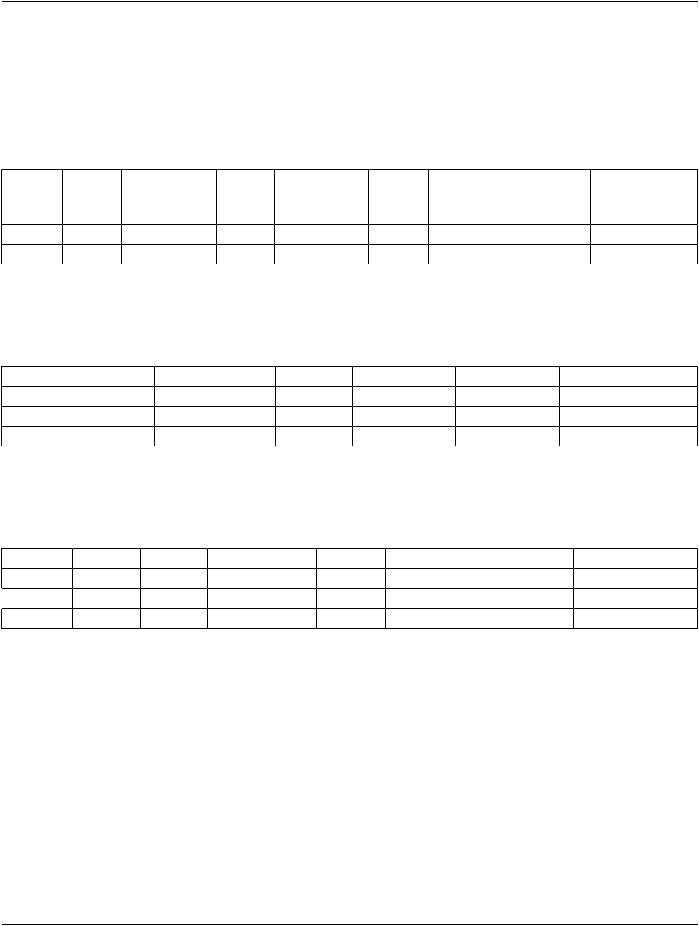
PS-2020a / part16
.pdf
DICOM PS3.16 2020a - Content Mapping Resource |
Page 71 |
2.13 C-RADS CT Colonography Reporting and Data System
[Zalis, 2005] Radiology. Zalis ME. 2005. 236. 1. 3-9. “CT Colonography Reporting and Data System: A Consensus Proposal”. 10.1148/radiol.2361041926.
2.14 Implants
[Eggli, 1998] J Bone Joint Surg Br. Eggli S, Pisan M, and Müller ME. 1998. 80-B. 3. 382-390. “The value of preoperative planning for total hip arthroplasty”. http://www.bjj.boneandjoint.org.uk/content/80-B/3/382 .
2.15 LOINC
[LOINC] Regenstrief Institute, Indianapolis. 2014. Logical Observation Identifier Names and Codes. http://loinc.org/ .
This product includes all or a portion of the LOINC® table, LOINC panels and forms file, LOINC document ontology file, and/or LOINC hierarchies file, or is derived from one or more of the foregoing, subject to a license from Regenstrief Institute, Inc. Your use of the LOINC table, LOINC codes, LOINC panels and forms file, LOINC document ontology file, and LOINC hierarchies file also is subject to this license, a copy of which is available at http://loinc.org/terms-of-use. The current complete LOINC table, LOINC Users' Guide, LOINC panels and forms file, LOINC document ontology file, and LOINC hierarchies file are available for download at http://loinc.org/. The LOINC table and LOINC codes are copyright © 1995-2014, Regenstrief Institute, Inc. and the Logical Observation Identifiers Names and Codes (LOINC) Committee. The LOINC panels and forms file, LOINC document ontology file, and LOINC hierarchies file are copyright © 1995-2014, Regenstrief Institute, Inc. All rights reserved.
The LOINC table (in all formats), LOINC panels and forms file, LOINC document ontology file, and LOINC hierarchies are provided "as is." Any express or implied warranties are disclaimed, including, but not limited to, the implied warranties of merchantability and fitness for a particular purpose.
A small portion of the LOINC table may include content (e.g., survey instruments) that is subject to copyrights owned by third parties. Such content has been mapped to LOINC terms under applicable copyright and terms of use. Notice of such third party copyright and license terms would need to be included if such content is included.
2.16 UCUM
[UCUM] Regenstrief Institute, Indianapolis. 2013. Unified Code for Units of Measure. http://unitsofmeasure.org/ .
This product includes all or a portion of the UCUM table, UCUM codes, and UCUM definitions or is derived from it, subject to a license from Regenstrief Institute, Inc. and The UCUM Organization. Your use of the UCUM table, UCUM codes, UCUM definitions also is subject to this license, a copy of which is available at http://unitsofmeasure.org/. The current complete UCUM table, UCUM Specific- ationareavailablefordownloadathttp://unitsofmeasure.org/.TheUCUMtableandUCUMcodesarecopyright©1995-2013,Regenstrief Institute, Inc. and the Unified Codes for Units of Measures (UCUM) Organization. All rights reserved.
The UCUM table (in all formats), UCUM definitions, and specification are provided "as is." Any express or implied warranties are disclaimed, including, but not limited to, the implied warranties of merchantability and fitness for a particular purpose.
2.17 Anesthesia Quality Institute Schema
[AQI Schema] Anesthesia Quality Institute, Schaumburg, IL. 2015/07/30. Anesthesia Quality Institute Schema. http://www.aqihq.org/ aqischdoc/default.html .
Used by permission of the Anesthesia Quality Institute (AQI) (http://www.aqihq.org/), established by the American Society of Anes- thesiologists (ASA).
2.18 Point-of-Care Medical Device Nomenclature
Extracts of ISO/IEEE 11073 reprinted by permission of IEEE, 3 Park Avenue, New York, NY 10016-5997 USA. Copyright by IEEE. http://standards.ieee.org/.
- Standard -

Page 72 |
DICOM PS3.16 2020a - Content Mapping Resource |
Under license from IEEE, the term codes and descriptions of the ISO/IEEE 11073 Nomenclature are available at no cost through the RosettaTerminologyMappingManagementSystemoftheU.S.NationalInstituteofStandardsandTechnology.http://rtmms.nist.gov/ rtmms/index.htm
[ISO/IEEE 11073-10101] ISO/IEEE. 2004. . Health informatics - Point-of-care medical device communication - Nomenclature.
[ISO/IEEE 11073-10101a] ISO/IEEE. 2015. . Health informatics - Point-of-care medical device communication - Nomenclature Amendment 1: Additional Definitions.
[ISO/IEEE 11073-10102] ISO/IEEE. 2015. . Health informatics - Point-of-care medical device communication - Annotated ECG - No- menclature.
2.19 SNOMED Clinical Terms
This DICOM Standard incorporates SNOMED CT®, used by permission of SNOMED International. SNOMED CT®, was originally created by The College of American Pathologists (CAP). SNOMED International was formerly known as the International Health Terminology Standards Development Organisation (IHTSDO).
The SNOMED CT terms used in this Standard (the SNOMED CT DICOM Subset) are the subject of a licensing agreement between NEMAandSNOMEDInternationalthatallowstheuseofthisdefinedsubsetinDICOMconformantapplicationswithoutfurtherlicense or payment of fee. Any use of SNOMED CT beyond the terms published in the DICOM Standard is subject to SNOMED CT licensing rules, which may include a fee. For further information about SNOMED CT licensing, go to http://www.snomed.org/snomed-ct/ get-snomed or contact SNOMED International at info@snomed.org.
This DICOM Standard incorporates various veterinary terms from the SNOMED CT VetSCT extension, used by permission of the Veterinary Terminology Services Laboratory (VTSL) (http://vtsl.vetmed.vt.edu/). These terms were previously included in SNOMED CT but have since been inactivated as moved elsewhere.
[SNOMED] SNOMED International. . SNOMED CT Systematized Nomenclature of Medicine - Clinical Terms.
2.20 Prostate Reporting Terminology and Nomenclature
TheProstateImagingandReportandDataSystemVersion2(PI-RADS)isajointeffortoftheEuropeanSocietyofUrogenitalRadiology,
the American College of Radiology and the AdMeTech Foundation.
[PI-RADS] Eur Urol. Weinreb JC, Barentsz JO, Choyke PL, Cornud F, Haider MA, Macura KJ, Margolis, D, Schnall, MD, Shtern, F, Tempany,CM.,Thoeny,HC,andVerma,S.2016/01.69.1.16-40.“PI-RADSProstateImaging-ReportingandDataSystem: 2015, Version 2”. 10.1016/j.eururo.2015.08.052. http://www.europeanurology.com/article/S0302-2838%2815%2900848-9/
.
Note
PI-RADS is also available from the following source:
•American College of Radiology: http://www.acr.org/~/media/ACR/Documents/PDF/QualitySafety/Resources/PIRADS/ PIRADS%20V2.pdf
[PI-RADS v2.1] Eur Urol. Turkbey B, Rosenkrantz AB, Haider MA, Padhani AR, Villeirs G, Macura KJ, Tempany, CM, Choyke PL, Cornud F, Margolis, D, Thoeny, HC, Verma, S, Barentsz JO, and Weinreb JC. 2019/09. 76. 3. 340–351. “Prostate Imaging Reporting and Data System Version 2.1: 2019 Update of Prostate Imaging Reporting and Data System Version 2”. 10.1016/j.eururo.2019.02.033. http://www.europeanurology.com/article/S0302-2838(19)30180-0/abstract .
[Prostate Eu Concensus] Eur Urol. Dickinson L, Ahmed HU., Allen C, Barentsz JO, Carey B, Futterer JJ, Heijmink SW, Hoskin PJ, Kirkham A, and Padhani AR. 2011. 59. 4. 477-94. “Magnetic resonance imaging for the detection, localisation, and charac- terisationofprostatecancer:recommendationsfromaEuropeanconsensusmeeting”.10.1016/j.eururo.2010.12.009. http:// www.europeanurology.com/article/S0302-2838(10)01187-5/ .
[ESUR Guidelines] Eur Radiol. Barentsz JO, Richenberg J, Clements R, Choyke P, Verma S, Villeirs G, Rouviere O, Logager V, and Fütterer JJ. 2012/04. 22. 4. 746-57. “ESUR prostate MR guidelines 2012”. 10.1007/s00330-011-2377-y. ht- tp://www.ncbi.nlm.nih.gov/pmc/articles/PMC3297750/ .
- Standard -

DICOM PS3.16 2020a - Content Mapping Resource |
Page 73 |
3 Definitions
For the purposes of this Standard the following definitions apply.
3.1 Codes and Controlled Terminology Definitions:
The following definitions are commonly used in this Part of the DICOM Standard:
Baseline Context Group |
Identifier that specifies the suggested Context Group for a Code Sequence Attribute. |
Identifier (BCID) |
See Table 5.6-1 “Conventions for Specification of Context Groups” in PS3.3. |
|
|
Baseline Template Identifier |
IdentifierthatspecifiesaTemplatesuggestedtobeusedinthecreationofasetofContentItems. |
(BTID) |
|
Coding Scheme |
Dictionary (lexicons) of concepts (terms) with assigned codes and well defined meanings. |
|
Note |
|
Examples of coding schemes include SNOMED and LOINC. |
Context Group |
A set of coded concepts defined by a Mapping Resource forming a set appropriate to use in a |
|
particular context. |
Context Group Version |
Version of a Context Group. |
Context ID (CID) |
Identifier of a Context Group. |
DefinedContextGroupIdentifier |
Identifier that specifies the Context Group for a Code Sequence Attribute that shall be used. |
(DCID) |
See Table 5.6-1 “Conventions for Specification of Context Groups” in PS3.3. |
|
|
Defined Template Identifier |
Identifier that specifies a Template that shall be used in the creation of a set of Content Items. |
(DTID) |
|
DICOM Content Mapping |
A Mapping Resource that defines Templates and Context Groups for use in DICOM IODs. |
Resource (DCMR) |
|
Extensible Context Group |
ContextGroupthatmaybeextendedbyaparticularapplicationbyinclusionofadditionalconcepts. |
|
See Table 5.6-1 “Conventions for Specification of Context Groups” in PS3.3. |
Extensible Template |
A Template that may be extended by a particular application by inclusion of additional Content |
|
Items beyond those specified in the Template. |
Mapping Resource |
A resource that defines context-dependent usage constraints (i.e., Value Set or Relationship |
|
Typerestrictions)forAttributes.Aresourcethatspecifiesthemappingofthecontentofanexternal |
|
controlled terminology to the components of a message standard. |
Non-Extensible Context Group |
Context Group whose defined set of concepts shall not be extended by an application. |
|
See Table 5.6-1 “Conventions for Specification of Context Groups” in PS3.3. |
Non-Extensible Template |
A Template that specifies the exact set of Content Items and corresponding Value Sets that shall |
|
be used and that shall not be extended by an application. |
Relationship Type |
The association between two Concepts. Examples: "HAS PROPERTIES", "CONTAINS", |
|
"INFERRED FROM". |
Root Template |
A Template whose first content item is a CONTAINER content item intended to be encoded in |
|
the top level Data Set of a SOP Instance. I.e., the "root node" of the "content tree". |
- Standard -

Page 74 |
DICOM PS3.16 2020a - Content Mapping Resource |
Template |
A pattern that describes the Content Items, Value Types, Relationship Types and Value Sets |
|
that may be used in part of a Structured Report content tree, or in other Content Item constructs, |
|
suchasAcquisitionContextorProtocolContext.AnalogoustoaModuleofanInformationObject |
|
Definition. |
Template ID (TID) |
Identifier of a Template. |
Value Set |
The allowed values of a Code Sequence Attribute in a given context. Specified either as one or |
|
more individual values or by reference to a Context Group. |
3.2 Information Object Definitions:
This Part of the Standard makes use of the following terms defined in PS3.3:
Code Sequence Attribute |
Code Sequence Attribute. |
3.3 Contrast Administration Definitions |
|
Imaging Agent |
A substance administered to improve the imaging of specific organs, tissues, diseases and |
|
physiological functions. Adapted from Wikipedia http://en.wikipedia.org/wiki/Imaging_agent. |
Note
1.ImagingagentsincludeiodinatedX-Rayandgadolinium-basedMRcontrastagents.
2.Saline flush is not an imaging agent but may be administered in conjunction with imaging agents.
3.Air used as a negative contrast agent is an imaging agent.
3.4 DICOM Introduction and Overview Definitions
This Part of the Standard makes use of the following terms defined in PS3.1:
Service-Object Pair Class (SOP Service-Object Pair Class (SOP Class).
Class)
3.5 DICOM Service Class Definitions
This Part of the Standard makes use of the following terms defined in PS3.4:
Service-Object Pair Instance Service-Object Pair Instance (SOP Instance).
(SOP Instance)
3.6 DICOM Data Structures and Encoding
This Part of the Standard makes use of the following terms defined in PS3.5:
Data Set |
Data Set. |
3.7 Radiotherapy |
|
Monitor Units (MU) |
AunitofradiationoutputusedtoquantifyaMeterset.SeeSectionC.36.1.1.3“Meterset”inPS3.3. |
- Standard -

DICOM PS3.16 2020a - Content Mapping Resource |
Page 75 |
4 Symbols and Abbreviations
The following symbols and abbreviations are used in this Part of the Standard.
Mammography |
Computer-Aided Detection and/or Computer-Aided Diagnosis for Mammography |
CAD |
Computer-Aided Detection and/or Computer-Aided Diagnosis for chest radiography |
Chest CAD |
|
Colon CAD |
Computer-Aided Detection and/or Computer-Aided Diagnosis for colon radiography |
ACR |
American College of Radiology |
ASE |
American Society of Echocardiography |
CAP |
College of American Pathologists |
DCMR |
DICOM Content Mapping Resource |
FHIR |
Fast Healthcare Interoperability Resources |
HTML |
HyperText Markup Language |
IHE |
Integrating the Healthcare Enterprise |
IHE SVS |
IHE Sharing Value Sets |
JSON |
JavaScript Object Notation |
NEMA |
National Electrical Manufacturers Association |
RECIST |
Response Evaluation Criteria In Solid Tumors |
SNOMED |
Systematized Nomenclature of Medicine |
UCUM |
Unified Code for Units of Measure |
WHO |
World Health Organization |
XML |
eXtensible Markup Language |
EV |
Enumerated Value |
DT |
Defined Term |
CNAME |
Context Group Name |
TNAME |
Template Name |
BCID |
Baseline Context Group ID |
DCID |
Defined Context Group ID |
ECID |
Enumerated Context Group ID |
BTID |
Baseline Template ID |
DTID |
Defined Template ID |
ETID |
Enumerated Template ID |
The following upper-case abbreviations represent specific Attributes:
CV Code Value (0008,0100) or Long Code Value (0008,0119) or URN Code Value (0008,0120) CSDCoding Scheme Designator (0008,0102)
CM Code Meaning (0008,0104) CSVCoding Scheme Version (0008,0103)
- Standard -

Page 76 |
DICOM PS3.16 2020a - Content Mapping Resource |
- Standard -

DICOM PS3.16 2020a - Content Mapping Resource |
Page 77 |
5 Conventions
Terms listed in Section 3 are capitalized throughout the document.
- Standard -

Page 78 |
DICOM PS3.16 2020a - Content Mapping Resource |
- Standard -

DICOM PS3.16 2020a - Content Mapping Resource |
Page 79 |
6 Form of Template Specifications
TemplatesarepatternsthatspecifytheConceptNames,Requirements,Conditions,ValueTypes,ValueMultiplicity,ValueSetrestric- tions, Relationship Types and other attributes of Content Items for a particular application.
An IOD may specify that particular Standard Templates shall be used or may be used to define or constrain the content of a Content Item construct. A Content Item construct includes a coded concept name and one of several types of coded values. Content Item constructs are used in:
•the main Data Set and recursively nested Content Sequences (0040,A730) of the SR Document Content Module
•the Acquisition Context Sequence(0040,0555) of the Acquisition Context Module,
•the Protocol Context Sequence (0040,0440) and Content Item Modifier Sequence (0040,0441) of the Scheduled Procedure Step Module, Image Acquisition Results Module, and others.
•the Specimen Preparation Step Content Item Sequence (0040,0612) of the Specimen Module.
Annexes A and C of this Part define Standard Templates.
Note
Standard Extended and Private Templates may be defined by implementers of the Standard. The rules for definition of Standard Extended and Private SR Templates are similar to the rules for definition of Standard Extended and Private SOP Classes. One row of a Template definition table corresponds to one row of a Module table.
Each Standard Template is specified by a Template table in this Part. Each Template table specifies exactly one Template, corres- ponding to a pattern of content within a Content Item construct.
Each Template table identifies whether the order of Content Items is significant or not significant. SOP Instances whose content is based on a Template where the order is significant shall encode the top level Content Items in the order they are specified in the Template, and the subsidiary Content Items under each parent item in the order they are specified, and so on for each Nesting Level. ThesignificanceoftheorderappliesonlytotheTemplateitself;subsidiaryincludedTemplatesmayhaveadifferentordersignificance.
Note
Even if a Template specifies that the order is not significant, there may be significance to the order in which Content Items are encoded in a SOP Instance. For example, CONTAINER Content Items with attribute Continuity of Content (0040,A050) value CONTINUOUS encode Content Items in narrative sequence, and procedure logs encode Content Items in time order.
The Content Items from subsidiary Templates may be intermingled if and only if the parent and subsidiary all specify that the order is not significant. This permits later refactoring into reusable Templates.
The range of concepts and the options that are permitted in a family of SR Documents vary inversely with the level of constraint that is applied by the corresponding SR Template. The more narrow the range of concepts and the more restricted the options permitted by a Template, the more predictable the content of the SR Documents will be.
Note
1.A very specific Template defines a family of SR Documents that are very similar to each other. They have a narrow range of content options (e.g., high level of constraint of Content Item values; use of CODE or NUM with Enumerated Context Groups) and their content is therefore highly predictable. A very general (e.g., permissive or broad) Template defines a family of SR Documents that may differ considerably from one another. They have a broader range of content options (e.g., low level of constraint of Content Item values; use of TEXT and relatively little restriction of Content Item values) and their content is less predictable.
2.The degree of interoperability that may be achieved with a family of SR Documents generated from a Template may be determinedintentionallyandpreciselyatadesiredlevelbyappropriateTemplatedesigntoachievethenecessarydegree of predictability of SR Document contents.
- Standard -

Page 80 DICOM PS3.16 2020a - Content Mapping Resource
6.1 Template Table Field Definition
SR Templates are described using tables of the following form:
Type: |
(Non-) Extensible |
Order: |
(Non-) Significant |
Root: |
Yes or No |
|
Table TID <#>. <SR Context Template Name> |
NL Rel with Parent VT |
Concept Name |
VM Req Type Condition |
Value Set |
|||
|
|
|
|
|
|
Constraint |
1 |
|
|
|
|
|
|
2 |
|
|
|
|
|
|
3 |
|
|
|
|
|
|
Acquisition Context Templates are described using tables of the following form: |
|
|
|
|||
Type: |
(Non-) Extensible |
|
|
|
|
|
Order: |
(Non-) Significant |
|
|
|
|
|
|
Table TID <#>. <Acquisition Context Template Name> |
|
|
|||
VT |
Concept Name |
VM |
Req Type |
Condition |
Value Set Constraint |
|
1 |
|
|
|
|
|
|
2 |
|
|
|
|
|
|
3 |
|
|
|
|
|
|
Protocol Context Templates are described using tables of the following form: |
|
|
|
|||
Type: |
(Non-) Extensible |
|
|
|
|
|
Order: |
(Non-) Significant |
|
|
|
|
|
|
Table TID <#>. <Protocol Context Template Name> |
|
|
|||
NL |
VT Concept Name VM |
Req Type |
Condition |
Value Set Constraint |
||
1 |
|
|
|
|
|
|
 2 3
2 3
Thesemanticsofthefields(columns)ofTemplatetablesaredefinedbysubsectionsofthisSection.ArowofaTemplatetablespecifies eitheroneContentItemorinclusionofanotherTemplatethatmayspecifyanynumberofContentItems(seeSection6.2.3fordefinition of Included Templates). Each Template table is named by a title, identified by a TID number and further explained by a description such as explanation of Template contents, purpose and use cases.
The following conventions are defined for the form of references to coded concepts, Context Groups and Templates.
Code Meanings are enclosed in quotation marks (for example "cm"). Code Values and Coding Scheme Designators are not enclosed in quotation marks unless a comma occurs in the string.
References to coded concepts take the following form:
•EV or DT (CV, CSD, "CM")
e.g., an Enumerated Value with only CV, CSD, and CM defined is represented as follows: EV (CV, CSD, "CM"), for example EV (76752008, SCT, "Breast").
•MemberOf { BCID or DCID (CID) CNAME } MemberOf selects one term from the specified context group.
- Standard -
